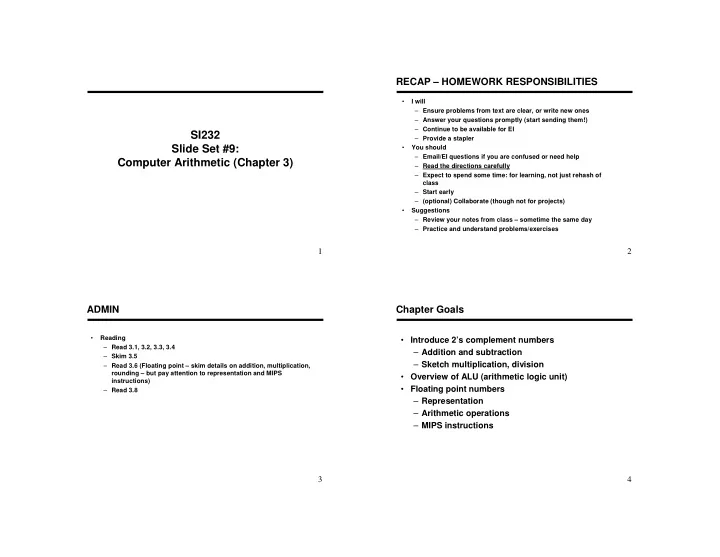

RECAP – HOMEWORK RESPONSIBILITIES I will • – Ensure problems from text are clear, or write new ones – Answer your questions promptly (start sending them!) – Continue to be available for EI SI232 – Provide a stapler Slide Set #9: You should • – Email/EI questions if you are confused or need help Computer Arithmetic (Chapter 3) – Read the directions carefully – Expect to spend some time: for learning, not just rehash of class – Start early – (optional) Collaborate (though not for projects) Suggestions • – Review your notes from class – sometime the same day – Practice and understand problems/exercises 1 2 ADMIN Chapter Goals Reading • • Introduce 2’s complement numbers – Read 3.1, 3.2, 3.3, 3.4 – Addition and subtraction – Skim 3.5 – Sketch multiplication, division – Read 3.6 (Floating point – skim details on addition, multiplication, rounding – but pay attention to representation and MIPS • Overview of ALU (arithmetic logic unit) instructions) • Floating point numbers – Read 3.8 – Representation – Arithmetic operations – MIPS instructions 3 4
Bits Bits as Numbers: Complications What do these two binary strings represent? Numbers are finite • • 0000 0000 0000 0000 0000 0000 0001 0101 0000 0001 0010 0011 0100 0101 0110 0111 Fractions and real numbers • Negative numbers • Bits are… • MIPS typically uses 32 bits for a number • – But we’ll often demonstrate with fewer for simplicity MSB vs LSB • _______________ define relationship between • __________ and ______________ 5 6 Integers: Possible 3-bit Representations of 2 and -2 Example Representations 1. Unsigned Unsigned Sign Mag. One's Comp. Two's Comp. 000 = +0 000 = +0 000 = +0 000 = +0 001 = +1 001 = +1 001 = +1 001 = +1 2. Sign and Magnitude 010 = +2 010 = +2 010 = +2 010 = +2 011 = +3 011 = +3 011 = +3 011 = +3 100 = +4 100 = -0 100 = -3 100 = -4 101 = +5 101 = -1 101 = -2 101 = -3 110 = +6 110 = -2 110 = -1 110 = -2 3. One's Complement 111 = +7 111 = -3 111 = -0 111 = -1 4. Two's Complement 7 8
Two's Complement Operations Exercise #1 Assume we have 4 bits. Convert the given decimal numbers to the stated binary • representations. Negating a two's complement number: invert all bits and add 1 • 5 -7 But must write down leading zero bits if there! • Example: • Unsigned – Express -6 10 in 8-bit binary 2’s complement: Sign Magnitude One’s Comp. Two’s Comp. 9 10 Exercise #2 Exercise #3 Convert the given decimal numbers to the stated binary representations. • Assume the following is in binary two’s complement form. • What do they represent in decimal? 001011 -3 -3 (using 4 bits) (using 6 bits) 111011 Sign Magnitude One’s Comp Now negate these numbers and show the new binary form: • -(001011) = Two’s Comp. - ( 111011) = 11 12
Exercise #4 – Stretch MIPS Given N bits, what is the largest and smallest number that each of the MIPS signed numbers use… • • following can represent? 32 bit signed numbers: • Min Max 0000 0000 0000 0000 0000 0000 0000 0000 two = 0 ten 0000 0000 0000 0000 0000 0000 0000 0001 two = + 1 ten 0000 0000 0000 0000 0000 0000 0000 0010 two = + 2 ten Unsigned ... 0111 1111 1111 1111 1111 1111 1111 1110 two = + 2,147,483,646 ten 0111 1111 1111 1111 1111 1111 1111 1111 two = + 2,147,483,647 ten Sign Magnitude 1000 0000 0000 0000 0000 0000 0000 0000 two = – 2,147,483,648 ten 1000 0000 0000 0000 0000 0000 0000 0001 two = – 2,147,483,647 ten 1000 0000 0000 0000 0000 0000 0000 0010 two = – 2,147,483,646 ten ... Ones Complement 1111 1111 1111 1111 1111 1111 1111 1101 two = – 3 ten 1111 1111 1111 1111 1111 1111 1111 1110 two = – 2 ten 1111 1111 1111 1111 1111 1111 1111 1111 two = – 1 ten Twos Complement 13 14 Two's Complement Operations Signed vs. unsigned numbers Some values don’t make sense as negative numbers Converting n bit numbers into numbers with more than n bits: • • – MIPS 16 bit immediate gets converted to 32 bits for arithmetic – copy the most significant bit (the sign bit) into the other bits MIPS allows values to be signed or unsigned • – 4 -> 8 bit example: Different instructions to deal with each case • – add vs. addu 0010 -> – lb vs. lbu – addi vs. addiu 1010 -> – slti vs sltiu Usually , the unsigned version will not ___________________ • – This is called Exception: • 15 16
Addition & Subtraction Addition & Subtraction Just like in grade school (carry/borrow 1s) Another example: • • 0111 0001 0111 0110 + 0001 + 0101 - 0110 - 0101 Easier way to subtract? • 17 18 Detecting Overflow Effects of Overflow Overflow -- result too large for finite computer word An exception (interrupt) occurs • • – Control jumps to predefined address for exception Is overflow possible if adding… • – Interrupted address is saved for possible resumption – a positive and a negative number? Details based on software system / language • – example: flight control vs. homework assignment – C always ignores overflow – two positive numbers? Don't always want to detect overflow • — “Unsigned” arithmetic instructions will ignore: addu, addiu, subu – two negative numbers? Subtraction: • – Invert the second number to test – So no overflow possible when signs are… 19 20
Summary: Advantages of Two’s Complement How to negate a number? • How many zeros? • How add positive and negative numbers? • Consequently, essentially all modern computers use this • 21
Recommend
More recommend